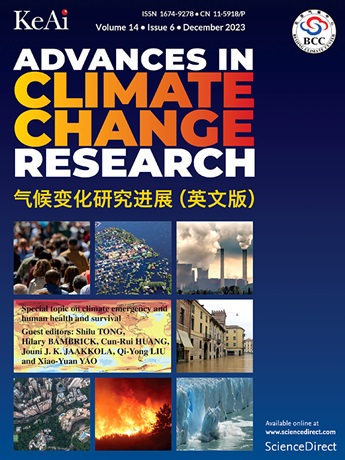全球变暖中断后,泛北极地区冻融指数和永久冻土范围发生了快速变化
IF 5.2
1区 地球科学
Q1 ENVIRONMENTAL SCIENCES
引用次数: 0
摘要
2013年全球变暖停滞期结束后,全球地表温度迅速上升。气温的快速上升有可能推动泛北极地区FDD/TDD和永久冻土范围的变化。本文分析了2003 - 2023年泛北极地区空气冻融指数(AFDD/ATDD)和地表冻融指数(GFDD/GTDD)的时空变化趋势,重点分析了2013年前后几十年的变化趋势。分析了多年冻土的变化。结果表明,从2003年到2023年,AFDD和GFDD显著(p <;0.05)以11.07°C d /年和5.34°C d /年的速率下降,而ATDD和GTDD显著(p <;0.05)分别以7.69°C d /年和4.34°C d /年的速率升高。全球变暖中断后,FDD/TDD变化迅速,2013年后AFDD和GFDD的下降速率分别增强至15.75°C d /年和6.27°C d /年,而ATDD和GTDD的上升速率分别增强至15.88°C d /年和8.50°C d /年。泛北极多年冻土区面积从2003-2013年的13.4 × 106 km2减少到2014-2023年的12.51 × 106 km2,年代际减少0.78 × 106 km2(6.64%)。自1901年以来,多年冻土面积的快速年代际减少超过了历史趋势预估的年代际变化,尽管在加拿大南部略有扩大。结果为FDD/TDD和永久冻土范围的近期变化提供了新的见解。本文章由计算机程序翻译,如有差异,请以英文原文为准。
The freezing‒thawing index and permafrost extent in pan-Arctic experienced rapid changes following the global warming hiatus
Global ground surface temperatures experienced a rapid increase following the end of the global warming hiatus in 2013. The rapid temperature increase has potential to drive changes in FDD/TDD and permafrost extent in pan-Arctic. In this study, the temporal and spatial trends of air freezing‒thawing index (AFDD/ATDD) and ground surface freezing‒thawing index (GFDD/GTDD) in pan-Arctic from 2003 to 2023 were analyzed, with a particular focus on the changes between the decades preceding and following 2013. The changes in permafrost extent were also analyzed. The results indicate that from 2003 to 2023, the AFDD and GFDD significantly (p < 0.05) decreased at rates of 11.07 and 5.34 °C d per year, while the ATDD and GTDD significantly (p < 0.05) increased at rates of 7.69 and 4.34 °C d per year, respectively. The FDD/TDD experienced rapid changes after the global warming hiatus, with the decreasing rates in AFDD and GFDD intensifying after 2013 to 15.75 °C d per year and 6.27 °C d per year, respectively, and increasing rates in ATDD and GTDD intensifying after 2013 to 15.88 °C d per year and 8.50 °C d per year, respectively. The permafrost area in pan-Arctic experienced a decline from 13.4 × 106 km2 in 2003–2013 to 12.51 × 106 km2 in 2014–2023, representing a decadal reduction of 0.78 × 106 km2 (6.64%). The rapid decadal reduction in permafrost extent surpassed the decadal changes projected by historical trend since 1901, despite a slight expansion in southern Canada. The results provide novel insights into recent changes in FDD/TDD and permafrost extent.
求助全文
通过发布文献求助,成功后即可免费获取论文全文。
去求助
来源期刊

Advances in Climate Change Research
Earth and Planetary Sciences-Atmospheric Science
CiteScore
9.80
自引率
4.10%
发文量
424
审稿时长
107 days
期刊介绍:
Advances in Climate Change Research publishes scientific research and analyses on climate change and the interactions of climate change with society. This journal encompasses basic science and economic, social, and policy research, including studies on mitigation and adaptation to climate change.
Advances in Climate Change Research attempts to promote research in climate change and provide an impetus for the application of research achievements in numerous aspects, such as socioeconomic sustainable development, responses to the adaptation and mitigation of climate change, diplomatic negotiations of climate and environment policies, and the protection and exploitation of natural resources.
 求助内容:
求助内容: 应助结果提醒方式:
应助结果提醒方式:


